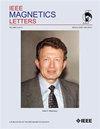Mean-Field Modeling of Magnetocaloric Effect of Antiferromagnetic Compounds
IF 1.1
4区 物理与天体物理
Q4 ENGINEERING, ELECTRICAL & ELECTRONIC
引用次数: 1
Abstract
Antiferromagnetic compounds are known in the literature to present the inverse magnetocaloric effect (MCE). This effect is characterized by the negative adiabatic temperature change反铁磁性化合物磁热效应的平均场模型
反铁磁性化合物在文献中已知具有反磁热效应(MCE)。这种效应的特点是负绝热温度变化$\Delta{T}_S反铁磁性材料在施加磁场时的$。在等温过程中,正熵变化$\Delta{S}_T预计还会有美元。最近,由于自旋翻转和自旋翻转跃迁,反铁磁性化合物的各向异性特性已经被指出,这突出了反铁磁化合物在旋转磁热器件中的适用性。在这项工作中,我们系统地研究了一个平均场模型,该模型以多元结构的方法描述了材料的反铁磁行为。我们的模型包括最近邻和次近邻交换相互作用、塞曼效应和单轴各向异性能量。我们研究了各向异性对自旋翻转和自旋翻转跃迁的影响。我们还演示并验证了$-{\rm{\Delta}}的区域规则{S}_T$对T曲线,可用于饱和磁化强度与磁场相关的化合物。
本文章由计算机程序翻译,如有差异,请以英文原文为准。
求助全文
约1分钟内获得全文
求助全文
来源期刊

IEEE Magnetics Letters
PHYSICS, APPLIED-
CiteScore
2.40
自引率
0.00%
发文量
37
期刊介绍:
IEEE Magnetics Letters is a peer-reviewed, archival journal covering the physics and engineering of magnetism, magnetic materials, applied magnetics, design and application of magnetic devices, bio-magnetics, magneto-electronics, and spin electronics. IEEE Magnetics Letters publishes short, scholarly articles of substantial current interest.
IEEE Magnetics Letters is a hybrid Open Access (OA) journal. For a fee, authors have the option making their articles freely available to all, including non-subscribers. OA articles are identified as Open Access.
 求助内容:
求助内容: 应助结果提醒方式:
应助结果提醒方式:


